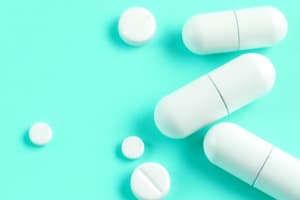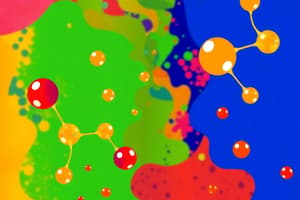Podcast
Questions and Answers
What advantage does anhydrous lactose have over hydrous lactose?
What advantage does anhydrous lactose have over hydrous lactose?
- It has a faster drug release rate.
- It is more effective as a binder.
- It does not undergo discoloration when aged. (correct)
- It has a lower cost than hydrous lactose.
What happens to anhydrous lactose when exposed to elevated humidity?
What happens to anhydrous lactose when exposed to elevated humidity?
- It converts into its hydrous form. (correct)
- It does not change at all.
- It reacts with drugs.
- It becomes less soluble.
When is hydrous starch typically used in tablet formulation?
When is hydrous starch typically used in tablet formulation?
- During wet granulation to improve binding. (correct)
- To enhance the disintegration time of tablets.
- As a binder when added as a dry powder.
- As a diluent when mixed with antibiotics.
What is one disadvantage of using the hydrous form of lactose in formulations?
What is one disadvantage of using the hydrous form of lactose in formulations?
For what purpose can dextrose be used in formulations?
For what purpose can dextrose be used in formulations?
What role does starch play when it is added dry at the beginning of the procedure?
What role does starch play when it is added dry at the beginning of the procedure?
Which of the following options describes the optimal use of starch in formulations?
Which of the following options describes the optimal use of starch in formulations?
What is the potential issue caused by using talc in formulations containing drugs sensitive to iron?
What is the potential issue caused by using talc in formulations containing drugs sensitive to iron?
Which of the following processes does NOT belong to tablet formulation?
Which of the following processes does NOT belong to tablet formulation?
What can happen if under-mixing occurs during tablet formulation?
What can happen if under-mixing occurs during tablet formulation?
What is one advantage of granules compared to individual fine powder ingredients?
What is one advantage of granules compared to individual fine powder ingredients?
Which statement best describes wet granulation in tablet manufacturing?
Which statement best describes wet granulation in tablet manufacturing?
What is a primary advantage of mannitol in chewable tablets?
What is a primary advantage of mannitol in chewable tablets?
Which of the following is an advantage of using microcrystalline cellulose as a diluent?
Which of the following is an advantage of using microcrystalline cellulose as a diluent?
What is a limitation associated with natural gums such as acacia and tragacanth as binders?
What is a limitation associated with natural gums such as acacia and tragacanth as binders?
Why is gelatin often preferred over natural gums as a binder?
Why is gelatin often preferred over natural gums as a binder?
What is a significant characteristic of starch when used as a binder?
What is a significant characteristic of starch when used as a binder?
How does mannitol affect the flowability of formulations?
How does mannitol affect the flowability of formulations?
What defines the compressibility of Avicel-containing tablets?
What defines the compressibility of Avicel-containing tablets?
Which factor is a disadvantage of using natural gums in formulations?
Which factor is a disadvantage of using natural gums in formulations?
What is a disadvantage of mannitol's expense in pharmaceutical applications?
What is a disadvantage of mannitol's expense in pharmaceutical applications?
What is one significant characteristic of croscarmellose sodium compared to starch in acidic media?
What is one significant characteristic of croscarmellose sodium compared to starch in acidic media?
Which statement accurately describes the function of lubricants in tablet manufacturing?
Which statement accurately describes the function of lubricants in tablet manufacturing?
What is a potential disadvantage of using liquid lubricants, such as mineral oils?
What is a potential disadvantage of using liquid lubricants, such as mineral oils?
What mechanism allows lubricants to reduce friction during tablet ejection?
What mechanism allows lubricants to reduce friction during tablet ejection?
How do antiadherents function in tablet formulation?
How do antiadherents function in tablet formulation?
Which of the following is not a known advantage of lubricants?
Which of the following is not a known advantage of lubricants?
What percentage of swelling is typical for starch in acidic media?
What percentage of swelling is typical for starch in acidic media?
Why are glidants used in tablet formulation?
Why are glidants used in tablet formulation?
Which of the following is true about crospovidone (Kollidon CL)?
Which of the following is true about crospovidone (Kollidon CL)?
What role does a glidant play when added to a tablet formulation?
What role does a glidant play when added to a tablet formulation?
What is the primary purpose of boundary lubrication in tablet formulations?
What is the primary purpose of boundary lubrication in tablet formulations?
Why should lubricants be added last, right before compression?
Why should lubricants be added last, right before compression?
What is the consequence of using more than 1% lubricant in a formulation?
What is the consequence of using more than 1% lubricant in a formulation?
What is the recommended particle size for effective lubricants in tablet formulations?
What is the recommended particle size for effective lubricants in tablet formulations?
What impact does over-mixing have on the efficacy of lubricants?
What impact does over-mixing have on the efficacy of lubricants?
What is the maximum mixing time recommended for adding lubricants to a tablet formulation?
What is the maximum mixing time recommended for adding lubricants to a tablet formulation?
Which lubricant is NOT suitable for use with alkaline drugs?
Which lubricant is NOT suitable for use with alkaline drugs?
What happens at high mixing rates when incorporating lubricants?
What happens at high mixing rates when incorporating lubricants?
Which lubricant is considered inert and has good lubricating properties?
Which lubricant is considered inert and has good lubricating properties?
What critical characteristic must lubricants possess to be effective in formulations?
What critical characteristic must lubricants possess to be effective in formulations?
Flashcards
Anhydrous Lactose Advantage
Anhydrous Lactose Advantage
Anhydrous lactose doesn't discolor when exposed to amines and alkalis during aging, unlike other types.
Lactose Moisture Absorption
Lactose Moisture Absorption
Anhydrous lactose can absorb moisture from the air, transforming to the hydrous form.
Lactose Tablet Packaging
Lactose Tablet Packaging
Lactose tablets should be packaged carefully to avoid moisture exposure to ensure their anhydrous form is maintained.
Lactose Tablet Usage in Wet Granulation
Lactose Tablet Usage in Wet Granulation
Signup and view all the flashcards
Lactose Tablet Advantages (General)
Lactose Tablet Advantages (General)
Signup and view all the flashcards
Hydrous Lactose Disadvantage
Hydrous Lactose Disadvantage
Signup and view all the flashcards
Dextrose Usage in Tableting
Dextrose Usage in Tableting
Signup and view all the flashcards
Mannitol use in tablets
Mannitol use in tablets
Signup and view all the flashcards
Mannitol's properties for tablets
Mannitol's properties for tablets
Signup and view all the flashcards
Microcrystalline cellulose (Avicel)
Microcrystalline cellulose (Avicel)
Signup and view all the flashcards
Avicel advantages
Avicel advantages
Signup and view all the flashcards
Tablet binders
Tablet binders
Signup and view all the flashcards
Acacia and tragacanth
Acacia and tragacanth
Signup and view all the flashcards
Gelatin as a binder
Gelatin as a binder
Signup and view all the flashcards
Starch as a binder
Starch as a binder
Signup and view all the flashcards
Starch hydrolysis
Starch hydrolysis
Signup and view all the flashcards
Superdisintegrants
Superdisintegrants
Signup and view all the flashcards
Croscarmellose Sodium
Croscarmellose Sodium
Signup and view all the flashcards
Lubricants in Tableting
Lubricants in Tableting
Signup and view all the flashcards
Antiadherents in Tableting
Antiadherents in Tableting
Signup and view all the flashcards
Glidants in Tableting
Glidants in Tableting
Signup and view all the flashcards
Fluid Lubrication
Fluid Lubrication
Signup and view all the flashcards
Problem with Liquid Lubricants
Problem with Liquid Lubricants
Signup and view all the flashcards
Lubricants and Tablet Ejection
Lubricants and Tablet Ejection
Signup and view all the flashcards
Lubricants and Die Life
Lubricants and Die Life
Signup and view all the flashcards
Lubricants and Friction Heat
Lubricants and Friction Heat
Signup and view all the flashcards
Boundary Lubrication
Boundary Lubrication
Signup and view all the flashcards
Lubricant Addition Timing
Lubricant Addition Timing
Signup and view all the flashcards
Lubricant Particle Size
Lubricant Particle Size
Signup and view all the flashcards
Tablet Formulation Process
Tablet Formulation Process
Signup and view all the flashcards
Lubricant Amount
Lubricant Amount
Signup and view all the flashcards
Lubricant Mixing Time
Lubricant Mixing Time
Signup and view all the flashcards
Mixing in Tablet Formulation
Mixing in Tablet Formulation
Signup and view all the flashcards
Lubricant Mixing Rate
Lubricant Mixing Rate
Signup and view all the flashcards
Granulation in Tablet Formulation
Granulation in Tablet Formulation
Signup and view all the flashcards
Magnesium Stearate
Magnesium Stearate
Signup and view all the flashcards
Wet Granulation: Tablet Formulation
Wet Granulation: Tablet Formulation
Signup and view all the flashcards
Talc as Lubricant
Talc as Lubricant
Signup and view all the flashcards
Stearic Acid
Stearic Acid
Signup and view all the flashcards
Zinc Stearate
Zinc Stearate
Signup and view all the flashcards
Lubricant Efficacy and Particle Size
Lubricant Efficacy and Particle Size
Signup and view all the flashcards
Study Notes
Excipients
- Excipients are non-drug materials in a formula
- Excipients are crucial for several reasons
- Improve patient compliance (color, flavor, sweeteners)
- Increase dosage form stability (antioxidants, preservatives)
- Increase dose accuracy (diluents, fillers)
- Act as process aids (binders, lubricants)
- Improve and control drug release (disintegrants, coating agents)
Types of Excipients
- Diluents (Fillers): lactose, starch, microcrystalline cellulose
- Binders (Granulating Agents): starch, acacia, gelatin
- Disintegrants: starch, super disintegrant
- Lubricant, Antiadherent, Glidants: magnesium stearate, stearic acid
Diluents (Fillers)
- Used to bulk up tablets when the drug alone isn't enough.
- Sometimes not needed if the drug has good compressibility.
- Round tablets are typically 5-13mm; smaller or larger tablets can be difficult to handle or swallow.
- Diluents improve tablet properties like cohesion and flow.
Lactose
- Widely used diluents in tablet formulation
- Doesn't react with most drugs.
- Three forms: anhydrous, hydrous, spray-dried
- Anhydrous is better for aging as it does not discolor (Maillard reaction).
- Anhydrous can absorb moisture and turn into hydrous form in humid environments.
- Hydrous form is often used with wet granulation.
Starch
- Derived from corn, wheat, or potatoes
- Used as diluent (50-60%), binder (2-10%), or disintegrant (5-20%) depending on the formula's needs.
- Added as a powder or paste in specific stages of tablet production.
Other Diluents
- Dextrose: Available as hydrous and anhydrous forms.
- Can be used as a replacement for lactose to minimize discoloration with alkaline compounds
- Mannitol: Used widely in chewable/orodispersible tablets due to its sweet taste, slow solubility and lack of hygroscopicity.
- Expensive, poor flow, requires high lubricant level
Microcrystalline Cellulose
- Often referred to as Avicel®
- Multipurpose excipient used as a diluent and disintegrant
- Inert, can be used with alkaline or acidic substances (no discoloration).
- High purity and low moisture content
- Directly compressible due to good compressibility and flowability
- Avicel-containing tablets have short disintegration times, high hardness, low friability and low variation in weight.
Binders (Granulating Agents)
- Bind particles together to form granules/compacts.
- Include acacia, tragacanth, gelatin, starch -paste.
- Acacia and tragacanth are natural gums and are more effective as solutions.
- Gelatin is a synthetic protein, preferred over acacia and tragacanth.
- Starch paste is a commonly used granulating agent.
Modified Natural Polymers
- Common binders such as Alginates, methylcellulose (MC), ethyl cellulose (EC), hydroxypropyl cellulose (HPC) and hydroxypropyl methylcellulose (HPMC)
- (Except for EC), used in powder form or as solutions.
- HPC can be used in alcoholic solution.
- EC is insoluble in water, used in alcoholic solution to prevent tablet disintegration.
Disintegrants
- Oppose the effect of the tablet binder, and physical force (applied during compression).
- Facilitate breakdown of tablets in GI fluids.
- Example of disintegrating agents are starch, and super disintegrant.
Starch (Disintegrants)
- Most widely used due to low cost.
- Quick water uptake and swelling leads to tablet rupture.
- Super disintegrants (Explotab®, croscarmellose sodium, crospovidone): powerful disintegrating agents
- Used at ratios of 5-20% of the tablet weight.
Lubricants, Antiadherents and Glidants
- Lubricants reduce friction during tablet ejection from the die cavity.
- Antiadherents reduce sticking of granules to die walls.
- Glidants promote granule flow by reducing friction between particles.
- Lubricants help with production and may influence bioavailability.
- Lubricants should be added to the surface of granules.
- Small particle size 200 mesh, larger particle size decrease efficacy.
- Mixing time (2-5 mins) and mixing rate (high mixing rate causes penetration and decreases efficacy) influence efficacy.
- Magnesium or Calcium stearate is the most widely used lubricant.
- Stearic acid is less effective than the salts, not used with alkaline drugs.
- Zinc stearate is effective in direct compression and is inert.
- Talc may also be used as a lubricant (contains iron so it has to be applied carefully).
Tablet Design and Formulation
- Tablet formulation involves weighing, granulation(wet/dry granulation is used for wet granule process / dry granule process / direct compression) , mixing, and compression.
- A crucial stage of the manufacturing process, uniform distribution (mixing), and adequate (appropriate/proper) distribution of lubricants is essential.
Mixing
- A critical step in tablet formulation.
- Uniform distribution of tablet constituents.
- Allows proper distribution of lubricants.
- Undermixing leads to impaired content uniformity, poor flow properties
- Overmixing leads to problems in the tablet manufacturing process such as poor flow properties due to lubricants entering into the tablet granules.
Granulation
- Addresses flowability and compressibility issues common in fine powder drugs.
- Granules have better flowability and compressibility than individual ingredients.
- Ensures the consistent distribution of API (active pharmaceutical ingredient) in the formulation.
Wet Granulation
- Common method using liquid binder.
- More steps; better control over the process.
- Involves mixing active ingredients, excipients and a liquid binder , followed by drying and milling to achieve the desired size.
Dry Granulation
- Used when granulating solutions are not suitable, especially with heat-sensitive drugs.
- Involves mixing drug powder, inactive ingredients and passing them through a roller, creating slugs, then milling/screening to the required size.
Direct Compression
- A method used when the drug and excipients are suitable for direct compression.
- Avoids a granulation step.
- Advantages include simplicity, lower labor and risk of ingredient deterioration.
- Requires certain properties in the active ingredient and/or excipients (crystalline nature and easy compressibility), limitation arises if intermolecular interaction is weak.
Compression
- Final step; requires careful evaluation of factors beyond this overview.
Tablet Compression Machine
- Comprises of a hopper, dies, punches, cam tracks.
- Also includes auxiliary equipment, such as automatic feeders and dusters (beyond this scope)
Studying That Suits You
Use AI to generate personalized quizzes and flashcards to suit your learning preferences.




